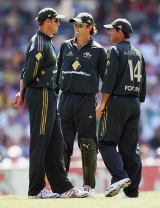The World Cup or the Well Cup?
The World Cup might just be won by the team who has 11 men standing by the final
18-Feb-2007
|
|

|
Will we see a spectacular cricket World Cup unfold over the next two months in the Caribbean or will it turn out to be the Well Cup, a trophy clinched by the team fortunate enough to have 11 men still standing?
The World Cup should be the most prestigious one-day tournament on the cricket calendar - designed to unearth the side with the greatest skill, determination and nous. However, with players currently going down like pins in a bowling alley, the cavorting in the Caribbean is shaping up to be more like a survival of the fittest frolic.
For months we have heard players and support staff justify every move by saying it is part of the planned lead-up to the World Cup. Now, as the tournament looms, players are being rested from competition so that niggling injuries can be healed in time for the start of the World Cup. That should be a hint to the programmers that the players are "cricket ready" and what they need is a little bit of time to fine tune and heal, rather than more matches.
Injuries are a fact of life for cricketers and they often come at the most inopportune time. They test the dedication of an individual and often determine how badly he wants to succeed. Equally, they provide opportunities for players and the best teams prosper despite the setbacks. Nevertheless, mental fatigue is the sportsman's greatest enemy and when players start thinking about saving themselves for something bigger and better, problems generally occur.
Is it any wonder with the demanding program of the last six months that many players are weary and injured and heaven knows how many are showing "empty" on the competitive juices gauge? In the case of Australia and England, they have played the Champions Trophy, a five-Test Ashes series, a month long one-day tournament and now they have to front up for the biggest tournament of all.
For the better players that means no mental let-up for seven months; no club or first-class match affording an opportunity to play in a more relaxed atmosphere, just hard grinding international cricket the whole way. And for good measure a Twenty20 match was squeezed in between the Test series and the one-day tournament just in case the players were thinking about putting their feet up for a day.
There can be no argument that if cricketers want to be well-paid they have to play regularly; the money is only available if big matches are programmed at appropriate times. However, equally true is the fact that if players are pushed too hard they will adopt their own measures to cope with the grind. This will include performing at a slightly reduced level (especially in the case of pace bowlers) and taking matches off.
|
|
The administrators in Australia see no problem with rotating players to monitor their work load but that can lead to a game or tournament being diminished.
Because India has the money they offer huge financial incentives to the individual boards to participate in tournaments and you don't see star players opting out of series being televised on the subcontinent. However, some of these events are designed for television and played where cricket isn't a major sport, in the name of globalising the game. There's every reason to globalise the game but when star players then miss tournaments being played in major cricket playing nations because they are weary it does seem to be defeating the purpose.
Already the high cost of obtaining the rights for ICC events is adversely affecting the way cricket is telecast. If a plethora of advertisements eventually leads to a downturn in viewers then less young fans will be attracted to the game.
The administrators need to strike the right balance between greed and good intentions. Somewhere between the measly three matches that were played in the six months leading up to the first World Cup in 1975 and the multitude that have been crammed into the days prior to the 2007 tournament there is an acceptable work load for players.
Even though the players may have been a little underdone for the 1975 tournament, the final was contested by the two best teams at the time, both of whom were at full strength. It was a well-played Cup final not a last-man-standing affair, which could occur at the 2007 showpiece.
Which team cuurently looks the fittest and thereby the likeliest to win the World Cup... or the Well Cup? Tell us here